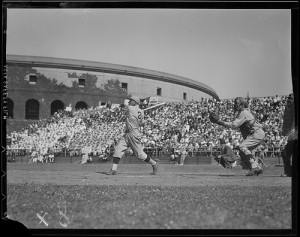 In light of my recent posts about mission (The Buggy Whip Lesson: Recognizing a Mission Crisis, The Metamission of Arts Institutions), Sept. 29th’s New York Times Op-Ed piece on baseball was fascinating. (“Is the Game Over?” by Jonathan Mahler) I found myself reading it and channeling discussions about the future of the arts into it. There are many points of overlap between Mr. Mahler’s analysis of Major League Baseball and the state of affairs in the arts industry.
In light of my recent posts about mission (The Buggy Whip Lesson: Recognizing a Mission Crisis, The Metamission of Arts Institutions), Sept. 29th’s New York Times Op-Ed piece on baseball was fascinating. (“Is the Game Over?” by Jonathan Mahler) I found myself reading it and channeling discussions about the future of the arts into it. There are many points of overlap between Mr. Mahler’s analysis of Major League Baseball and the state of affairs in the arts industry.
Here are just a few quotations:
As crazy as it sounds, baseball was once celebrated for its speed. . . . Mark Twain called it a symbol of “the drive and push and rush and struggle of the raging, tearing, booming 19th century!”
The point, of course, is that society has changed and, in the context of 21st-Century life, baseball is no longer seen as a fast-paced sport. As I said in a much earlier post (Things Change), “[B]efore the 20th Century, the loudest thing typical people ever heard (by far) was a symphony orchestra. No machines, no cars, certainly no jet airplanes. So the effect of hearing a large orchestra playing forté (or fortissimo!) in an auditorium must have been mind-boggling rather than merely entertaining.” The arts are still powerful, but, because of the ways the world has changed, they are not as viscerally overwhelming as they were in the past.
[B]etween 1961 and 1998, the number of franchises almost doubled. You might think that spreading baseball across the country would be good for the game, and in some ways it was: more franchises equaled more spectators. In the process, though, a lot of teams wound up in cities without deep roots in the game.
The proliferation of arts organizations (local arts agencies–arts service LAA’s–as well as arts organizations) fueled by the NEA (among other factors) in the period from 1965-1980 was even more explosive.
Baseball’s never-ending nostalgia trip has made it an inherently conservative sport . . . .
The focus on great (European) works of the past at the expense of contemporary work or work rooted in cultural expressions more familiar to newer members of society similarly makes many of our institutions seem to be highly conservative bastions. In addition, our artcentricity precludes us from addressing the interests of “non-believers.” This is a bit like the baseball world’s obsession with statistics. Indeed, I had been thinking about writing a post entitled “Inside Baseball” about the difficulty outsiders have in feeling welcomed into the arts establishment. (From Wikipedia–forgive me academic colleagues: “‘[I]nside baseball’ refers to a detail-oriented approach to the minutiae of a subject, which in turn requires such a specific knowledge about what is being discussed that the nuances are not understood or appreciated by outsiders.”)
With its 162-game season, it was the default sport; there was always a baseball game on. There still is, it’s just that now there are so many alternatives.
The point that people have many alternatives to the programming we offer is a fairly widely-shared understanding. However, we can’t afford to ignore the very real implications of that truth.
“[B]randing” is undignified for our national pastime.
This observation recognizes that we might need to do things differently in communicating with the public if we want to reach the public. (Tip-of-the-hat to Trevor O’Donnell,)
Unfortunately, Mr. Mahler’s conclusion represents a bit of wishful thinking that’s not helpful for us:
Yes, [baseball]’s quiet and slow, but if you hang in there, through all of the pitching changes and batting-glove adjustments, you might get caught up in the drama. If you don’t, there’s plenty else to watch.
There’s a whistling in the dark quality to that even though there is an acknowledgement in the last sentence that there may be trouble. It’s the trouble for the future of the arts industry that concerns me. (I don’t have any skin in the game re: baseball.) The parallels to Mr. Mahler’s analysis of the situation in baseball are fairly striking. For us in the arts, change is necessary: change that seeks broader and deeper relationships with the communities in which we work.
Engage!
Doug
Photo: ![]()
![]()
![]() Some rights reserved by Boston Public Library
Some rights reserved by Boston Public Library

It’s funny that you talk about the parallels between the arts and baseball as an industry, and are encouraging us to engage. Here in Pittsburgh, where the Pirates have just had their first winning season (and first playoff appearance) since 1992, there is the renewed connection that goes with having a winning team. But it’s also clear that the Pirates’ ownership group has done what it can to see that by using its charitable arm to make partnerships between the players and community organizations and to support the creation of better youth baseball fields, among other initiatives. So there’s a couple of forms of engagement for you at the major league level.
Check out an essay by Donald Barthelme called Mao Tse Tung and the Art of Baseball. He theorized fans would be turned off when player salaries (and strikes) dominated the sport. Something similar is happening in the orchestra world and, with the recent labor discussions at San Francisco Ballet, with dancers. The challenges to many ways of doing business–journalism, sports, arts, even intelligence work–are presented by the digital age.